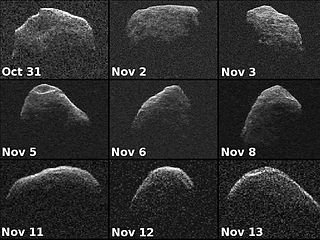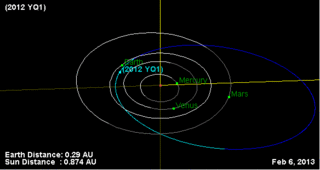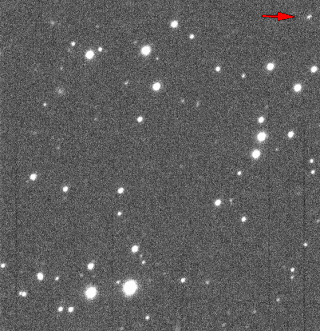
(29075) 1950 DA, provisional designation 1950 DA, is a risk-listed asteroid, classified as a near-Earth object and potentially hazardous asteroid of the Apollo group, approximately 1.1 kilometers in diameter. It once had the highest known probability of impacting Earth. In 2002, it had the highest Palermo rating with a value of 0.17 for a possible collision in 2880. Since that time, the estimated risk has been updated several times. In December 2015, the odds of an Earth impact were revised to 1 in 8,300 (0.012%) with a Palermo rating of −1.42. As of 2022, It is listed on the Sentry Risk Table with the second highest cumulative Palermo rating of −2.05. 1950 DA is not assigned a Torino scale rating, because the 2880 date is over 100 years in the future.
1998 KY26 is a nearly spherical sub-kilometer asteroid, classified as a near-Earth object of the Apollo group. It measures approximately 30 meters (100 feet) in diameter and is a fast rotator, having a rotational period of only 10.7 minutes. It was first observed on 2 June 1998, by the Spacewatch survey at Kitt Peak National Observatory during 6 days during which it passed 800,000 kilometers (half a million miles) away from Earth (a little more than twice the Earth–Moon distance).
(292220) 2006 SU49, provisional designation 2006 SU49, is a sub-kilometer asteroid, classified as near-Earth object and potentially hazardous asteroid of the Apollo group that had a small chance of impacting Earth in 2029.
2008 HJ is a sub-kilometer asteroid, classified as near-Earth object of the Apollo group.

2010 TD54 is a tiny asteroid and fast rotator, classified as a near-Earth object of the Apollo group, approximately 5 meters in diameter. It was first observed by the Mount Lemmon Survey in October 2010, when the asteroid crossed through the Earth-moon system and had a close encounter with Earth.
(242450) 2004 QY2 (prov. designation:2004 QY2) is an asteroid on an eccentric orbit, classified as near-Earth object and potentially hazardous asteroid of the Apollo group, approximately 3 kilometers (2 miles) in diameter. It was discovered on 20 August 2004 by the Siding Spring Survey at an apparent magnitude of 16.5 using the 0.5-metre (20 in) Uppsala Southern Schmidt Telescope. It is one of the largest potentially hazardous asteroids known to exist.

(214869) 2007 PA8 is an asteroid and slow rotator, classified as near-Earth object and potentially hazardous asteroid of the Apollo group, approximately 1.4 kilometers in diameter.
(471240) 2011 BT15, provisional designation 2011 BT15, is a stony, sub-kilometer sized asteroid and fast rotator, classified as a near-Earth object and potentially hazardous asteroid of the Apollo group. It had been one of the objects with the highest impact threat on the Palermo Technical Impact Hazard Scale.

2012 YQ1 is a sub-kilometer asteroid, classified as a near-Earth object and a potentially hazardous asteroid of the Apollo group, approximately 200 meters in diameter. It was first observed on 19 December 2012, by astronomers Andrey Oreshko and Timur Kryachko at the Elena Remote Observatory (G32) located in the Chilean Atacama desert.

(511002) 2013 MZ5, provisional designation 2013 MZ5, is a sub-kilometer asteroid, classified as a near-Earth object of the Amor group, estimated to measure approximately 300 meters (1,000 feet) in diameter. It was discovered on 18 June 2013, by astronomers with the Pan-STARRS survey at Haleakala Observatory on the island of Maui, Hawaii, in the United States. It was the 10,000th near-Earth object ever discovered.
(86039) 1999 NC43, is an asteroid on an eccentric orbit, classified as near-Earth object and potentially hazardous asteroid of the Apollo group, approximately 2 kilometers in diameter. This suspected tumbler and relatively slow rotator was discovered by LINEAR in 1999.

2014 RC is a sub-kilometer near-Earth object and Apollo asteroid. The exceptionally fast rotator passed within 0.000267 AU (39,900 km; 24,800 mi) (0.1 lunar distances) of Earth on 7 September 2014. The asteroid is approximately the diameter of the Chelyabinsk meteor, and passed almost as close to Earth as 367943 Duende (2012 DA14) did in 2013.
2001 AV43 is a very small, monolithic asteroid and fast rotator, classified as a near-Earth object of the Apollo group, approximately 30 meters (98 feet) in diameter. It was first observed on 5 January 2001, by astronomers of the LINEAR program at Lincoln Laboratory's Experimental Test Site near Socorro, New Mexico, in the United States. The presumed S-type asteroid has a rotation period of only 10 minutes. It has an exceptionally low MOID of 0.66 lunar distance (LD) and will approach Earth at 0.81 LD on 11 November 2029.

2017 XO2, also written 2017 XO2, is a sub-kilometer asteroid and near-Earth object of the Apollo group approximately 110 meters (360 feet) in diameter. The asteroid was discovered by Pan-STARRS in December 2017, after it already had approached Earth at 0.051 AU (7,600,000 km) or 20 lunar distances (LD) on 6 November 2017. On 26 April 2057, it will pass Earth at a similar distance of 21 LD again.

(505657) 2014 SR339, provisional designation 2014 SR339, is a dark and elongated asteroid, classified as near-Earth object and potentially hazardous asteroid of the Apollo group, approximately 970 meters (3,200 feet) in diameter. It was discovered on 30 September 2014, by NASA's Wide-field Infrared Survey Explorer telescope (WISE) in Earth's orbit. Closely observed at Goldstone and Arecibo in February 2018, it has a rotation period of 8.7 hours.

2018 BD is a small asteroid and near-Earth object of the Apollo group, approximately 2–6 meters (7–20 ft) in diameter. It was first observed on 18 January 2018, by astronomers of the Catalina Sky Survey at Mount Lemmon Observatory, Arizona, United States, just hours before passing about 0.10 lunar distances from the Earth.
2020 HS7 is a very small asteroid classified as a near-Earth object of the Earth-crossing Apollo group. When it was discovered by the Pan-STARRS 2 survey on 27 April 2020, the asteroid was initially calculated to have a 10% chance of impact with Earth before being ruled out by improved orbit determinations from additional observations. Although there is now no risk of impact with Earth, it did make a close approach 42,700 kilometres (26,500 mi) from Earth on 28 April 2020, with a flyby speed of 15.6 kilometres per second (9.7 mi/s) relative to Earth. The asteroid will not make any close encounters within 1 lunar distance (380,000 km; 240,000 mi) of Earth in the next 100 years.

2016 DV1 is a near-Earth asteroid estimated to be roughly 29–65 meters (95–210 feet) in diameter. It is a fast rotating asteroid of the Apollo group which was first observed by the Mount Lemmon Survey on 28 February 2016, just days before it passed Earth at 1 lunar distance (LD) on 3 March 2016. The elongated fast rotator has a rotation period of 303 seconds. It was recovered in February 2021 as it was about to pass Earth on 3 March 2021 at a distance of 0.0053 AU (2.1 LD; 790,000 km; 490,000 mi).
2020 SW is a tiny near-Earth asteroid discovered by the Mount Lemmon Survey on 18 September 2020, six days before it made its closest approach to Earth. The asteroid passed within 21,600 kilometres (13,400 mi) from Earth's surface on 24 September 2020 11:13 UT, within the geostationary altitude of 36,000 kilometres (22,000 mi). The encounter with Earth perturbed the asteroid's heliocentric trajectory from an Apollo-type orbit to an Aten-type orbit with a semi-major axis within one astronomical unit from the Sun. As a result, the asteroid will not make any close approaches to Earth within 0.01 astronomical units (4 LD) in the next 200 years.
2021 DW1 is a small Apollo near-Earth asteroid discovered on 16 February 2021 by the Pan-STARRS 1 survey at Haleakala Observatory, Hawaii. On 4 March 2021 at 8:59 UTC, it passed 1.48 LD (570,000 km; 350,000 mi) from Earth. During the close approach, it trailed across the Northern Hemisphere sky and brightened up to apparent magnitude of 14.6. Extensive observations of 2021 DW1 during the encounter revealed that it is an elongated, stony asteroid approximately 30 metres (100 ft) in diameter, with a rapid rotation period of 50 seconds. The asteroid's spin axis is unusually oblique relative to its orbital plane, contrary to predictions from the YORP effect.










